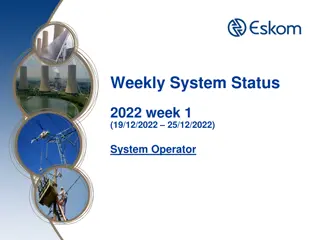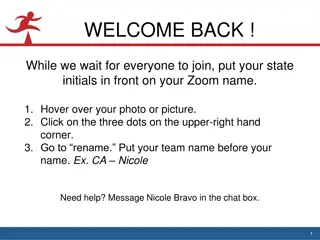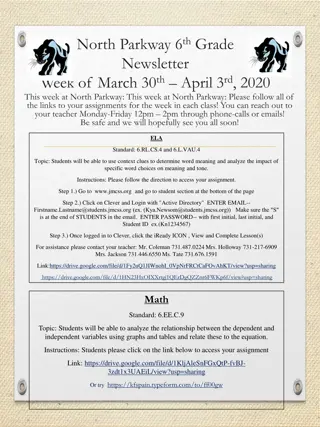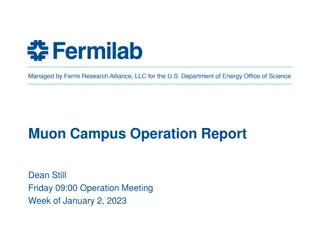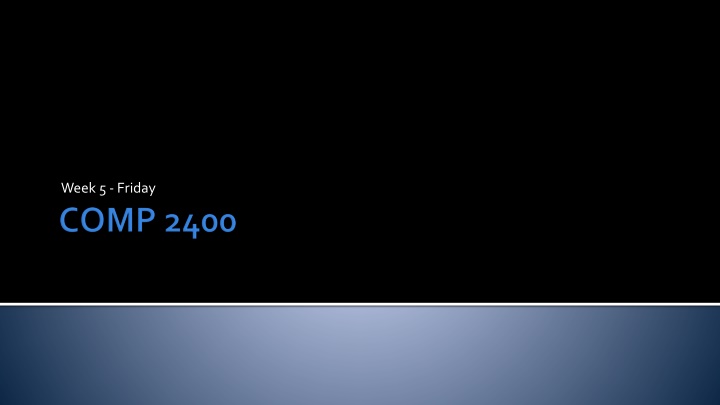
Basic Types and Versions in C Programming
Explore the fundamental concepts of C programming, including basic data types and versions, such as signed and unsigned integers. Learn about the differences between C and Java, the history of Unix operating systems, and the significance of Linus Torvalds' contributions. Find out about the requirements to call an OS "Unix" and the specifications set by The Open Group. Delve into the details of Linux kernel development and the impact of BSD distributions.
Download Presentation

Please find below an Image/Link to download the presentation.
The content on the website is provided AS IS for your information and personal use only. It may not be sold, licensed, or shared on other websites without obtaining consent from the author. If you encounter any issues during the download, it is possible that the publisher has removed the file from their server.
You are allowed to download the files provided on this website for personal or commercial use, subject to the condition that they are used lawfully. All files are the property of their respective owners.
The content on the website is provided AS IS for your information and personal use only. It may not be sold, licensed, or shared on other websites without obtaining consent from the author.
E N D
Presentation Transcript
What did we talk about last time? Finished arrays Strings
It's a standard for operating systems based on a long, complex history with many companies and innovators The Open Group has the trademark on the term "UNIX," and you're only allowed to call your OS Unix if it meets their Single UNIX Specification Linux and FreeBSD and other free implementations of Unix do notmeet this specification
Linus Torvalds started working in 1991 to make a Unix kernel to run on an Intel 386 He put Linus's Unix (Linux) under the GNU GPL The BSD distributions also gave rise to free BSD implementations (notably FreeBSD), but their usage is much less widespread than Linux Linux kernel version numbers are x.y.z where xis a major version, y is a minor version, and zis a minor revision
Basic types in C are similar to those in Java, but there are fewer Type Meaning Size char Smallestaddressable chunk of memory Usually1 byte short Shortsigned integer type Atleast 2 bytes int Signedinteger type At least 2 bytes, usually 4 bytes long Long signed integer type At least 4 bytes float Single precisionfloating point type Usually 4 bytes double Double precision floating point type Usually 8 bytes There's a bool in C99 but not in C90
Unlike Java, C has signed and unsigned versions of all of its integer types Perhaps even worse, there's more than one way to specify their names Type EquivalentTypes char signed char unsigned char short signed short short int signed short int unsigned short int unsigned short int signed int unsigned int unsigned long signed long long int signed long int unsigned long int unsigned long
The standard Hello World program is simpler in C, since no external classes are needed #include <stdio.h> int main() { } printf("Hello, World!\n"); return 0;
Makefiles are called makefile or Makefile all: hello hello: hello.c gcc -o hello hello.c clean: rm -f *.o hello
Know how to convert between all of the following: Base 2 (binary) Base 8 (octal) Base 10 (decimal) Base 16 (hexadecimal)
You can also write a literal in hexadecimal or octal A hexadecimal literal begins with 0x int a = 0xDEADBEEF; Hexadecimal digits are 0 9 and A F (upper or lower case) An octal literal begins with 0 int b = 0765; Octal digits are 0 7 Be careful not to prepend other numbers with 0, because they will be in octal! Remember, this changes only how you write the literal, not how it is stored in the computer Can't write binary literals in standard C (even though gcc allows it)
Using a normal base 10 to base 2 conversion works fine for unsigned integer values However many bits you've got, take the pattern of 1's and 0's and convert to decimal What about signed integers that are negative? Most modern hardware (and consequently C and Java) use two's complement representation
Let's say you have a positive number n and want the representation of n in two's complement with k bits 1. Figure out the pattern of k 0's and 1's for n 2. Flip every single bit in that pattern (changing all 0's to 1's and all 1's to 0's) This is called one's complement 3. Then, add 1 to the final representation as if it were positive, carrying the value if needed
Okay, how do we represent floating point numbers? A completely different system! IEEE-754 standard One bit is the sign bit Then some bits are for the exponent (8 bits for float, 11 bits for double) Then some bits are for the mantissa (23 bits for float, 52 bits for double)
They want floating point values to be unique So, the mantissa leaves off the first 1 To allow for positive and negative exponents, you subtract 127 (for float, or 1023 for double) from the written exponent The final number is: (-1)sign bit 2(exponent 127) 1.mantissa
For both integers and floating-point values, the most significant bit determines the sign But is that bit on the rightmost side or the leftmost side? What does left or right even mean inside a computer? The property is the endianness of a computer Some computers store the most significant bit first in the representation of a number These are called big-endian machines Others store the least significant bit first These are called little-endian machines
Function Result Function Result cos(double theta) exp(double x) Cosine of theta ex sin(double theta) log(double x) Sine of theta Natural logarithm of x tan(double theta) log10(double x) Tangent of theta Common logarithm of x pow(double base, double exponent) Raise base to power exponent acos(double x) Arc cosineof x asin(double x) sqrt(double x) Arc sineof x Square root of x atan(double x) ceil(double x) Arc tangent of x Round up value of x atan2(double y, double x) floor(double x) Arc tangent of y/x Round down value of x fmod(double value, double divisor) Remainder of dividing value by divisor fabs(double x) Absolute value of x
There are preprocessor directives which are technically not part of the C language These are processed before the real C compiler becomes involved The most important of these are #include #define Conditional compilation directives
We said that the size of int is compiler dependent, right? How do you know what it is? sizeof is a built-in operator that will tell you the size of a data type or variable in bytes #include <stdio.h> int main() { printf("%d", sizeof(char)); int a = 10; printf("%d", sizeof(a)); double array[100]; printf("%d", sizeof(array)); return 0; }
In Java, constants are specified with the final modifier In C, you can use the keyword const Note that const is only a suggestion The compiler will give you a warning if you try to assign things to const values, but there are ways you can even get around that const double PI = 3.141592; Arrays have to have constant size in C Since you can dodge const, it isn't strong enough to be used for array size That's why #define is more prevalent
C uses one byte for a char value This means that we can represent the 128 ASCII characters without a problem In many situations, you can use the full 256 extended ASCII sequence In other cases, the (negative) characters will cause problems Beware the ASCII table! Use it and die!
Now that we have a deep understanding of how the data is stored in the computer, there are operators we can use to manipulate those representations These are: & Bitwise AND | Bitwise OR ~ Bitwise NOT ^ Bitwise XOR << Left shift >> Right shift
Operators in every programming language have precedence Some of them are evaluated before others Just like order of operations in math * and / have higher precedence than + and = has a very low precedence I don't expect you to memorize them all, but Know where to look them up Don't write confusing code
Type Operators () [] .-> expr++ expr-- * & + - ! ~ ++expr --expr (typecast)sizeof * / % + - >> << < > <= >= == != & ^ | && || ?: = += -= *= /= %= >>= <<= &= ^= |= , Associativity Primary Expression Left to right Unary Right to left Binary Left to right Ternary Right to left Assignment Right to left Comma Left to right
Like Java, the body of an if statement will only execute if the condition is true The condition is evaluated to an int True means not zero Sometimes this is natural and clear; at other times it can be cryptic. An else is used to mark code executed if the condition is false
We can nest if statements inside of other if statements, arbitrarily deep Just like Java, there is no such thing as an elseif statement But, we can pretend there is because the entire if statement and the statement beneath it (and optionally a trailing else) is treated like a single statement
switch statements allow us to choose between many listed possibilities Execution will jump to the matching label or to default (if present) if none match Labels must be constant (either literal values or #define constants) Execution will continue to fall through the labels until it reaches the end of the switch or hits a break Don't leave out break statements unless you really mean to!
C has three loops, just like Java while loop You don't know how many times you want to run for loop You know how many times you want to run do-while loop You want to run at least once Like if statements, the condition for them will be evaluated to an int, which is true as long as it is non-zero All loops execute as long as the condition is true
Avoid the following constructs except when necessary: break Leaves loop immediately Necessary for switch statements continue Jumps to bottom of loop immediately Avoid the following construct always: goto
Kernel The part of the OS that does everything important Process A currently running program Shell The program you type commands into Users and groups Users that can log in to the machines and logical groupings of them for permission purposes Superuser The user that can do everything, often named root Files All input and output in Unix/Linux is viewed as a file operation
type name( arguments ) { statements }
You don't have to specify a return type But you should int will be assumed if you don't If you start calling a function before it has been defined, it will assume it has return type int and won't bother checking its parameters
Because the C language is older, its compiler processes source code in a simpler way It does no reasonable typechecking if a function is called before it is defined To have appropriate typechecking for functions, create a prototype for it Prototypes are like declarations for functions They usually come in a block at the top of your source file
C does not force you to return a value in all cases The compiler may warn you, but it isn't an error Your function can "fall off the end" Sometimes it works, other times you get garbage int sum(int a, int b) { int result = a + b; return result; } int sum(int a, int b) { int result = a + b; }
Two parts: Base case(s) Tells recursion when to stop For factorial, n = 1 or n = 0 are examples of base cases Recursive case(s) Allows recursion to progress "Leap of faith" For factorial, n > 1 is the recursive case
long long factorial( int n ) { if( n <= 1 ) return 1; else return n*factorial( n 1 ); } Base Case Recursive Case
The scope of a name is the part of the program where that name is visible In Java, scope could get complex Local variables, class variables, member variables, Inner classes Static vs. non-static Visibility issues with public, private, protected, and default C is simpler Local variables Global variables
If there are multiple variables with the same name, the one declared in the current block will be used If there is no such variable declared in the current block, the compiler will look outward one block at a time until it finds it Multiple variables can have the same name if they are declared at different scope levels When an inner variable is used instead of an outer variable with the same name, it hides or shadows the outer variable Global variables are used only when nothing else matches Minimize variable hiding to avoid confusion
C files All the sources files that contain executable code Should end with .c Header files Files containing extern declarations and function prototypes Should end with .h Makefile File used by Unix make utility Should be named either makefile or Makefile
To declare an array of a specified type with a given name and a given size: type name[ size ]; Example with a list of type int: int list[ 100 ];
When you declare an array, you are creating the whole array There is no second instantiation step It is possible to create dynamic arrays using pointers and malloc(), but we haven't talked about it yet You must give a fixed size (literal integer or a #define constant) for the array These arrays sit on the stack in C Creating them is fast, but inflexible You have to guess the maximum amount of space you'll need ahead of time
You can access an element of an array by indexing into it, using square brackets and a number list[9] = 142; printf("%d", list[9]); Once you have indexed into an array, that variable behaves exactly like any other variable of that type You can read values from it and store values into it Indexing starts at 0 and stops at 1 less than the length Just like Java
The length of the array must be known at compile time There is no length member or length() method It's unwise to use sizeof()
Using an array in a function where it wasn't created is a little different You have to pass in the length The function should list an array parameter with empty square brackets on the right of the variable No brackets should be used on the argument when the function is called Like Java, arguments are passed by value, but the contents of the array are passed by reference Changes made to an array in a function are seen by the caller
An array takes up the size of each element times the length of the array Each array starts at some point in computer memory The index used for the array is actually an offset from that starting point That s why the first element is at index 0
Unfortunately, C does not recognize strings as a type A string in C an array of char values, ending with the null character Both parts are important It's an array of char values which can be accessed like anything else in an array Because we don't know how long a string is, we mark the end with the null character
Write a function change() with the following prototype: char change(char value); This function takes value and returns the opposite case char Examples: If value is 'A', it returns 'a' If value is 'x', it returns 'X' If value is not a letter, it returns the input unchanged: '$' goes to '$'
Write a function quadratic() with the following prototype: void quadratic(double a, double b, double c); This function takes values a, b, and c that represent coefficients in a quadratic equation: ??2+ ?? + ? = 0 Use the quadratic formula ? = ? ?2 4?? answers to this equation Print both answers out with exactly 3 points after the decimal to find the two 2?











